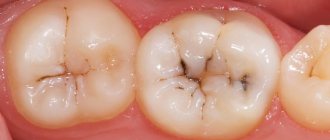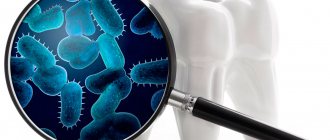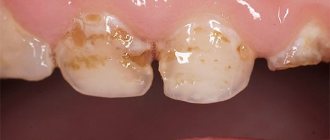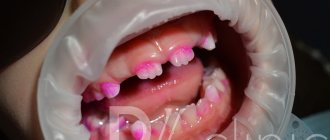Sanitation of the oral cavity in children
Most diseases can be cured in a very short time and without causing much discomfort or pain to the patient, although it is necessary to diagnose the problem in time and consult a specialist.
An event such as planned sanitation of the oral cavity in children allows us to identify the presence of any dental diseases (caries, pulpitis, periodontitis, gingivitis, etc.) and begin treatment as soon as possible. During this event the following procedures may be carried out:
- elimination of dental tissue defects,
- removal of tartar,
- anti-inflammatory therapy (necessary for gingivitis),
- preparation of the oral cavity for dental prosthetics.
Concept
Even healthy teeth require constant care to maintain their natural beauty. Age-related changes, previous illnesses or irregular hygiene procedures complicate the dentist’s work. This situation is typical for most people, and the possibilities of aesthetic medicine make it possible to eliminate a huge part of such shortcomings. Incorrect positioning of teeth, their damage or absence can be corrected by sanitation of the oral cavity. The implementation and order of the necessary procedures are determined individually and may require several visits to the dentist.
Sanitation of the oral cavity
– is a set of measures aimed at correcting all defects of the oral cavity. Treatment of gums and teeth, dental orthopedics and prosthetics are the most important areas in such recovery. After completing all the necessary procedures, the patient receives completely healthy teeth and an aesthetically perfect dentition. Oral sanitation is not a one-time procedure and is carried out throughout life. This approach will provide an opportunity to prevent the development of dental diseases, which will have a positive impact on health and the cost of dental services.
Features of reorganization
It is considered mandatory to carry out this procedure in preschool age, during pregnancy and for conscripts. But, let's talk about children!
According to the schedule in kindergartens, schools, sanatoriums, camps, etc. Visits are organized to the dental department of the clinic, where the doctor examines each small patient. Such an event, as a rule, is planned, although it can also be carried out on the initiative of parents who suspect the development of any disease in the child. You can be examined at any time at the clinic at your place of residence.
Stages of oral cavity sanitation:
First of all, the doctor uses special equipment to conduct an examination. The following is a definition of the necessary measures for sanitation of the oral cavity. Among them may be:
- removal of teeth that cannot be restored;
- caries treatment,
- replacement of defective fillings.
After completion of this work, orthopedic treatment begins, which is prosthetics (carried out, as a rule, in adults).
If a malocclusion is diagnosed in a child, he will be referred to an orthodontist. With this diagnosis, the number of visits to the dentist will increase to 2-3 per year, during which the specialist will monitor the progress of treatment and give recommendations on how to care for braces (they are most often used to straighten the bite).
Even if there are no special problems with teeth, the patient is recommended to undergo procedures such as:
- removal of tartar,
- professional teeth cleaning.
This will prevent the development of caries and other diseases that may arise due to poor oral care, unbalanced nutrition, and improper daily routine.
What procedures are carried out
Sanitation of the oral cavity is a complex event that includes several sequential operations:
- Step 1. Inspection by a specialist.
At this stage, the dentist interviews the patient about complaints, previous diseases and methods of their treatment. An examination of the oral cavity is carried out using the necessary instruments, the bite, the condition of the teeth, and their mobility are assessed. - Step 2. Based on the examination performed by a specialist, a conclusion is drawn and a diagnosis is announced.
- Step 3. Eliminate detected problems.
- Step 4. Recommendations from the dentist for oral care to avoid future problems.
The process of sanitation of the oral cavity may consist of the following procedures:
- removing deposits such as bacterial plaque and tartar from the enamel;
- carrying out effective therapy when periodontitis or gingivitis, stomatitis and other diseases of the teeth and gums are detected to prevent further inflammation;
- removal of damaged and decayed teeth, removal of roots;
- treatment of teeth damaged by caries;
- orthodontic measures, if necessary - correction of incorrect placement of teeth in relation to each other;
- removal and replacement of defective fillings, sealing;
- orthopedic measures - dental prosthetics.
The operations listed above can be supplemented by other procedures necessary to improve the health of the oral cavity in each individual case.
Why do you need to perform oral sanitation?
Every adult who is faced with treatment, prosthetics and removal of molars probably understands that the reason for this was ignorance of sanitation. Therefore, the importance of such an event is obvious. This allows you not only to save on treatment (getting rid of caries is much easier than curing pulpitis, for example), but also to prevent the baby from the pain that these diseases can cause.
In addition to observing scheduled visits to the clinic, parents should teach their children the rules of personal hygiene. Teeth cleaning should be done efficiently. It wouldn't hurt to introduce activities such as rinsing your mouth after meals and using dental floss to clean out food debris. A comprehensive approach to health is the best solution!
What is oral sanitation?
Today, modern dentistry calls sanitization a set of effective measures, the purpose of which is to ensure the health of all organs in the oral cavity and the prevention of dental diseases. When a dentist examines the oral cavity, he identifies diseases that the patient has had for a long time.
It can be either caries or some others:
It is especially important for children and adolescents to see a dentist. An important point is to keep your teeth healthy, so sanitation should also be done by adults who are preparing for surgery, going on business trips or traveling.
An infection that develops in the mouth can be a source of disease in other organs. To prevent this, foci of infection must be eliminated in time. Bacteria in the mouth are just as dangerous. The toxins they produce affect a person’s overall well-being.
What kind of rehabilitation is there?
Sanitation of the oral cavity can be different:
- If the patient himself decides to come to the dental clinic for diagnosis and treatment. This type of rehabilitation is called individual.
- The patient comes to the dentist to receive a certificate of oral sanitation. This kind of rehabilitation is called planned.
- Periodic sanitation is prescribed for patients with chronic diseases.
Rehabilitation stages:
- First, you need to undergo an examination by a dentist to find out about the presence of any diseases. The stage includes a visual examination of the oral cavity and an assessment of further actions.
- Next, a special photograph of all teeth is taken , which is called panoramic. It is better if it covers the entire chewing-jaw apparatus. The ideal option is a modern 3D image when new computer technologies are used.
- Afterwards, professional cleaning is carried out to remove excess plaque and stones.
- It is necessary to draw up a treatment plan with the right doctors: periodontist, therapist, surgeon and several more.
- Successful implementation of the action plan : caries is treated, teeth that cannot be cured are removed. Incorrectly grown wisdom teeth are also removed. Therapy is carried out to relieve inflammation. If necessary, prosthetics are performed, the malocclusion is corrected, and the treatment ends.
- Also, during rehabilitation, you can replace old or damaged fillings , whiten teeth and schedule further visits to the doctor.
Sanitation of the oral cavity is always carried out in stages. At the end of the procedure, the dentist will give a short lecture on how to properly brush your teeth and care for the oral cavity, how to choose dental floss or the right brush, and about the mandatory rinsing of your mouth both after brushing and after each meal.
Read also: How to cure mouth ulcers quickly
What is natural dental sanitation, or Teeth that are naturally healthy?
It’s hard to imagine, but there are people who have never visited a dentist’s office in their lives! And not at all because they are afraid of the sound of a drilling machine or cannot stand people in white coats. It’s just that such people have naturally healthy and strong teeth.
Moreover, these lucky people are characterized by the so-called natural sanitation of the teeth and oral cavity, in which a person practically does not develop caries or other diseases of the oral cavity.
Find out if you are one of those lucky ones right now!
Natural sanitation of the oral cavity
What is natural sanitation of teeth and oral cavity, and what factors influence it, read in our article.
What it is?
Today, dental problems arise already from school. Caries, stomatitis, periodontitis and other dental diseases occur very often and in almost everyone. At the same time, there is a very small number of people who have never experienced any problems with their teeth, despite their already mature age. Dentists call this phenomenon natural sanitation.
Favorable factors
Dental health largely depends on two fundamental factors: genetic and natural. It is worth noting that climate and environmental conditions begin to affect us even in the womb. In this regard, the dental health of the unborn child also largely depends on the pregnant woman’s body, her diet, stress, bad habits and many other factors.
The role of genetic factors was discussed back in the 70s of the last century. Resistance to diseases (in particular, caries) largely depends on genetic predisposition, belonging to a particular race, etc.
Negative factors
Unfortunately, there are a lot of factors that negatively affect the condition of our oral cavity, which explains the prevalence of dental diseases.
First of all, the development of certain diseases of the teeth and oral cavity depends on the nature of nutrition and adherence to hygiene rules. Excessive consumption of sweets promotes the proliferation of pathogenic microorganisms that contribute to the development of caries. If you do not properly maintain the cleanliness of the oral cavity, then the likelihood of developing caries is very high.
You need to understand that the process of bacteria formation in the oral cavity occurs constantly. By your actions, you can either contribute to this or control this process, which will allow you to maintain the health of your teeth for a long time. Residues of food stuck in the oral cavity begin to ferment after some time, forming acids that aggressively affect tooth enamel.
Another negative factor is premature teething, when the teeth are immature, which makes them vulnerable to caries.
Technological progress is another factor that has a serious impact on the condition of the human oral cavity. Over time, humanity has invented (and continues to invent) new devices that allow us to live life in more comfortable conditions.
Unfortunately, you have to pay for comfort, even at the cost of your own health. Increasingly, the diet of a modern person includes processed and refined foods that require virtually no effort to get into the stomach. Due to the reduced load on the chewing teeth, they constantly change their shape and structure.
For example, the teeth of our ancestors were more massive and durable.
How to keep your mouth clean
As you already understand, the health of your teeth depends on factors that you cannot influence (genetic predisposition, environment, climate) and factors that completely depend on your lifestyle. This is something that deserves special attention.
First of all, careful hygienic care of the oral cavity is necessary, which must be carried out systematically! You need to brush your teeth at least 2 times a day and also remove plaque from your tongue and cheeks. After each meal, the mouth should be rinsed with warm water to wash away food debris.
Particular attention should be paid to nutrition. A person needs up to 100 grams of proteins and fats, up to 500 grams of carbohydrates and up to 0.1 grams of vitamins per day. It is better to minimize the consumption of sweets.
It is also worth considering the fact that the condition of the oral cavity also depends on the condition of the whole organism: the digestive system, immune, endocrine and nervous systems. Timely treatment of concomitant diseases will protect you from many problems with teeth and gums. And, of course, don’t forget to get regular checkups with your dentist.
Likar.info:
(7576)
Source: https://www.artofcare.ru/top/7573.html
In what cases is oral sanitation necessary?
Every year, sanitation becomes more and more commonplace. It is carried out in various institutions and institutions on a compulsory basis. Twice a year it is necessary to conduct an examination and undergo planned procedures.
Some preschools and schools have their own dental offices. At the request of each parent, the child can undergo such a procedure. But in some children's institutions, sanitation is mandatory. Military personnel and conscripts must undergo a compulsory inspection. If necessary, then carry out sanitation.
Sanitation is also done in order to obtain a special certificate. If you are planning to travel or go on an expedition , then you will need a certificate in order to prepare the necessary documents.
Diseases for which it is necessary to undergo sanitation:
- Diabetes;
- Asthma;
- Rheumatism;
- Heart diseases;
- Allergy;
- Chronic sore throat and tonsillitis.
The frequency of sanitation will depend on the degree of neglect of the teeth and the state of certain diseases.
What is the difficulty in registration?
There may be some difficulties on the way to obtaining a document confirming the satisfactory condition of your teeth. For example, a certificate is needed to enroll a child in an educational institution urgently, but the doctor discovers some kind of disease. Treatment can take a very long period. During this time, another may be accepted to take your child's place.
Or, people who do not undergo a professional examination in a timely manner may simply not be allowed to perform their work duties.
Video on the topic:
Sanitation of the oral cavity during pregnancy
For every woman, pregnancy is a special period. In which the body and the entire system are rebuilt. Very often, when there is a lack of certain substances, such as calcium and fluoride, caries appears .
The best option would be if a woman undergoes a dental sanitation procedure during planning. This will be needed in order to avoid major problems in the future that could affect the baby’s health. If a woman has dental caries, her immunity will be reduced, and as a result, fewer nutrients will reach the baby through milk.
Also, cariogenic flora will be the start for caries in a child immediately after teething.
If a pregnant woman puts off dental treatment until later, she may develop gingivitis , in which the gums become inflamed and bleed and cause pain. Treatment of gingivitis in pregnant women cannot be delayed, otherwise periodontitis . As a result, it will turn into pulpitis and periodontitis if it is not treated on time.
In order for a child to be born healthy , you will have to follow several rules. In the modern world, there is no need to be afraid of the negative impact of treatment on the fetus during pregnancy. The main thing is to notify the attending physician about the due date, then he will be able to choose a harmless treatment for the expectant mother and baby.
During your entire pregnancy, you will need to come to the dentist three times for examination . Carry out oral hygiene with a full range of all procedures. Try to brush your teeth after every meal. Fluoride should be the main component of toothpaste. A pregnant woman should consume foods containing calcium as much as possible.
The second trimester of pregnancy is suitable for the treatment of caries. Prosthetics and implantation are undesirable procedures for an expectant mother. Teeth will be removed only if there is severe pain or special anesthesia will be used, which is intended for pregnant women.
When might a certificate be needed?
Oral sanitation is a procedure that absolutely everyone, young and old, undergoes. Therefore, it can be requested for various purposes.
- Pregnancy. The antenatal clinic must refer you for examination to a dentist upon registration. This is done in order to prevent many unpleasant consequences that can happen to the oral cavity during pregnancy due to changes in hormonal levels.
- Help before childbirth. I send the woman to the maternity hospital, the local gynecologist who managed the pregnancy again sends the patient for sanitation.
- Without this certificate, the child will not be accepted into any educational institution, from preschool to higher and vocational.
- Those who are about to have a planned operation will also have to visit the dentist to get the coveted opinion.
- An annual medical examination is also not complete without a dentist’s note.
- People who work in some kind of hazardous environment or in production where dental pathologies can develop. In other words, all employees of chemical plants, as well as in confectionery shops, must be regularly examined by a dentist.
Oral sanitation for children
Timely sanitation of the oral cavity in children plays an important role. Preventive measures are aimed at improving the health of a small organism and reducing the likelihood of disease at an older age. At the same time, dentists carry out hygiene of the mucous membrane.
Children are sanitized in several ways:
- A group or class goes to an appointment at the clinic;
- The dentist arrives at the educational institution along with his equipment.
When visiting a dentist, the doctor will teach you how to use a brush correctly, show you how best to brush your teeth, and teach you proper oral hygiene in general.
How to brush your teeth correctly
After sanitation of the oral cavity, the dentist gives recommendations on how to care for your teeth and gums at home. A mandatory measure for the prevention of dental diseases is the correct movements of the toothbrush. As the practice of doctors shows, a huge number of people use “harmful” teeth brushing techniques, which provoke problems with gums and enamel.
Proper brushing of teeth with toothpaste and brush is as follows:
- The brush is positioned at an angle of 45 degrees to the gums.
- Sweeping movements are made from the gums to the cutting edge.
- The chewing surface is cleaned away from the molars.
- At least 10 movements with the brush are made in each area.
- After cleaning, the mouth is rinsed with water.
It is recommended to sanitize the oral cavity every year, and to go to the dentist for an examination to avoid complex treatment every 3-4 months.
What is oral sanitation and why is such a procedure performed?
Very often, people are faced with the fact that they are prescribed oral sanitation. What is it, what are the indications and stages of its implementation? We'll tell you in more detail below. After all, it is always better to know what you have to go through in the dentist’s or any other doctor’s office.
This procedure can be prescribed to both a child and an adult at different periods of life. Depending on how we monitor oral hygiene, keep our teeth clean and healthy, completely different manipulations will be carried out.
What is this procedure?
The word “sanatio” is translated from Latin as “healing, treatment.” Therefore, sanitation means a whole range of procedures aimed at ensuring oral health. This includes:
- treatment of caries and other dental diseases;
- elimination of inflammatory processes;
- restoration of the structure of hard tissues, filling;
- correction of the bite and position of uneven teeth;
- installation of prostheses if necessary;
- removal of plaque, tartar, professional cleaning;
- extraction of those units that cannot be cured;
- preventing future diseases and tissue infections.
Of course, everything will directly depend on the condition of the teeth and periodontal tissue in the mouth of a particular patient.
Indications for use
In order to keep hard tissues in a healthy state, it is advisable to visit the dentist every six months and carry out sanitation, that is, examination of the oral cavity and timely treatment of emerging problems. This is what conscious people do who monitor their health.
Read also: Bubbles in the mouth
In other cases, it may be necessary to undergo sanitization:
- when planning a pregnancy, registering with a antenatal clinic;
- before childbirth;
- when a child enters a child care institution - kindergarten, school;
- before installing braces;
- before surgery;
- during long-term hospitalizations;
- before traveling abroad;
- official employment;
- work in hazardous industries;
- in general terms of regular annual medical examination of employees;
- when installing a prosthesis or implantation, etc.
It is worth noting that there are no contraindications to sanitation. On the contrary, some chronic diseases require more frequent use.
For example, for allergies, asthma, gingivitis, tonsillitis, diabetes, and various problems of the cardiovascular system, doctors recommend undergoing a sanitation procedure up to four times a year. Since in such cases, teeth are more susceptible to infection and destruction due to reduced immunity.
To obtain a dentist’s opinion on such a procedure, you should visit any dental clinic and undergo a series of procedures. Depending on the condition of your teeth and soft tissues, the number of actions will differ, but in general, oral sanitation consists of the following:
- Examination by a dentist, making diagnostic assumptions and prescribing some additional procedures.
- An X-ray of the jaw is taken, covering not only the problem areas, but also the entire functional apparatus.
- Perform professional cleaning to remove plaque and tartar.
- If there are diseases of hard or soft tissues, the doctor draws up a treatment plan. Sometimes other specialists are involved for this purpose - surgeons, orthodontists, periodontists, etc.
- The actual recovery stage will strictly depend on what is discovered and what problems need to be eliminated.
- To strengthen the enamel and saturate it with additional minerals, the doctor can coat hard tissues with a special gel polish containing increased amounts of fluoride and calcium.
- If some diseases have become chronic and require periodic observation or therapeutic intervention, then the patient is registered with a clinical examination clinic.
- A doctor’s report is given, written according to a general template, which can indicate all the manipulations performed.
- Sometimes the dentist also draws up an additional schedule of visits and observations at the clinic for long-term treatment.
Regardless of all variations, teeth cleaning with professional products is a universal and mandatory procedure. But the treatment can be very different depending on the patient’s specific problems - tooth extraction, filling, implantation, prosthetics, bite alignment, treatment of inflamed gums and periodontal disease, etc.
Stages of manipulation
The procedure for improving the oral cavity is divided into 3 categories:
- individual;
- planned;
- periodic.
A description of each of them can be found in the table.
Sanitation includes a set of the following manipulations:
- treatment of oral diseases, including the elimination of caries;
- restoration of the integrity of teeth and dentition through fillings and prosthetics;
- removal of tartar and plaque using ultrasonic cleaning;
- correction of bite and incorrect positioning of incisors;
- tooth extraction;
- elimination of inflammation in the oral cavity;
- prevention of the development of inflammatory processes in the future.
What is included in oral sanitation? The number of manipulations will depend primarily on the health of the patient’s gums and teeth. For some, it will include half the list of listed procedures, while for others, only removal of tartar and cleaning of enamel will be required.
Many, having heard a recommendation from a dentist about holding an event, are afraid that it will be painful. As a rule, it all depends on the procedures required in a particular case. And if there is a risk of pain, the doctor will always suggest anesthesia.
To obtain a dental report, you need to visit the clinic and undergo a number of necessary procedures. Complete sanitation of the oral cavity includes the following steps:
- dental examination;
- making diagnostic assumptions regarding the need for dental procedures;
- taking an x-ray of the problem area;
- ultrasonic cleaning, removal of plaque and tartar;
- drawing up a plan for further treatment if necessary;
- involvement of other specialists - surgeons, orthodontists, periodontists in the presence of specific diseases of the oral cavity;
- carrying out health procedures;
- coating with gel polish containing calcium and fluorine;
- registration at a dispensary in the presence of chronic diseases or pathologies that require long-term observation of the patient after their elimination;
- issuance of a specialist’s opinion (certificate of oral sanitation, a sample of which is established on a general basis for both private and public dental clinics);
- drawing up an individual additional visit schedule if long-term monitoring is necessary.
Any option for sanitation of the oral cavity includes the removal of tartar and plaque. But the rest of the list of procedures - filling, prosthetics, implantation, tooth extraction, bite correction, etc. is carried out only if necessary and with the consent of the patient.
Sanitation of the oral cavity during pregnancy
It is advisable to undergo a consultation with a dentist and the necessary treatment of teeth or gums before the start of pregnancy. In any case, when registering at the antenatal clinic, the doctor will definitely require a certificate of sanitation. Where can I get one? In any dentist’s office - in a government institution or a private clinic.
The peculiarities of a pregnant woman’s condition are the processes occurring at this time in her body. These include hormonal changes, active growth of the fetus and various related problems. Particularly acute is the lack of minerals such as phosphorus and calcium, as well as some vitamins, which leads to popular dental problems among pregnant women:
- swollen gums;
- pain while eating;
- bleeding;
- the appearance of white spots on the enamel;
- increased sensitivity to cold and hot foods;
- rapid development of caries.
It is undesirable to ignore such problems, since they will not only worsen the well-being of the expectant mother, but can also significantly affect the overall development of the fetus and the health of the child immediately after birth. After all, an infection that quickly spreads in the oral cavity easily enters the female body, and there it negatively affects the fetus.
Even the need to take an x-ray can now be carried out in such a delicate position. For this purpose, some rooms are equipped with a special radiovisiograph. It affects locally in a volume of several centimeters, without harming the body as a whole. Also, modern medications and local anesthesia do not penetrate the placenta and are completely safe for the fetus.
As soon as your baby's first baby teeth appear, you should periodically show him to the dentist. It is very important to keep them clean, since the health of the permanent units that will appear after them directly depends on this.
When entering an official institution, for example, a kindergarten, the child must be shown to a specialist. He will identify the first possible problems and give recommendations on maintaining hygiene procedures or prescribe some available treatment. In this case they can do the following:
- detect the beginning of carious processes;
- perform filling of affected teeth;
- if necessary, fluoridate or silver plate individual units;
- If a malocclusion is detected, orthodontic treatment and installation of braces are prescribed.
It is important that parents teach their child to visit the dentist’s office on time and not to be afraid of this doctor. Only by establishing positive contact is it possible to ensure that the child trusts the specialist, allows all manipulations to be carried out and does not resist treatment. Pediatric dentistry is considered more complex precisely due to the problems in establishing such a trusting relationship between the doctor and the patient.
Tooth extraction during pregnancy
Complex dental procedures, such as extractions, are performed during pregnancy according to strict indications when there is a risk of complications. Tooth extraction during pregnancy is possible, and it is better to do this in the second trimester. Nowadays, most dental procedures are safe during pregnancy, and the prognosis largely depends on the woman’s psychological mood and the professionalism of the doctor.
Indications for tooth extraction in a pregnant woman will be:
- acute pain without the possibility of pain relief;
- purulent inflammation with the formation of flux;
- tooth decay with infection of periodontal tissue.
Is anesthesia possible for dental treatment during pregnancy?
A limited list of drugs is used as anesthesia during pregnancy. The most commonly used drug is Ultracain. This product does not contain adrenaline and does not penetrate the hemoplacental barrier. During one visit to the dentist, a pregnant woman can be administered no more than 6 carpules of the drug.
When do you need a certificate of oral sanitation?
If you perform such an examination regularly to maintain the health of your teeth and gums, then a certificate as such is not needed. In cases where you were referred to a dentist for sanitation from a clinic, antenatal clinic, or are required in some other official institutions, then you should get the appropriate certificate from the dentist or he will make an entry in the general medical record.
Read also: How to cure a sore in the mouth
Usually this is needed:
- upon admission to kindergarten;
- school;
- At work;
- when crossing the border;
- for trips to children's camps or other health institutions;
- during general therapeutic treatment or medical examination;
- for military service.
How much does this procedure cost? Depending on the clinic you contacted and the specific measures taken, the amount may vary greatly. After all, if you only cleaned from plaque and tartar, you will get the same amount, but when filling several teeth or prosthetics, the cost of all manipulations will be completely different.
Video: sanitation of the oral cavity with a Biolase Epic diode laser.
Is it possible to carry out the procedure at home?
Since people don’t really like visiting the dentist’s office, a similar question often arises - will it be possible to do the sanitation on your own? Let us say right away that it is impossible to carry out the entire range of required procedures at home. After all, this requires both equipment and the help of a specialist. You cannot even diagnose the condition of your teeth and gums yourself.
All that is available for maintaining oral health at home is regular cleaning and treatment of surfaces, following general recommendations, rinsing after meals and using high-quality devices for this.
Only a doctor can fully examine all the teeth, clean hard-to-reach places, make a diagnosis, do fillings, etc. Moreover, if installation of dentures, braces or full periodontal treatment, tooth extraction, pulp removal and other complex manipulations are required.
Features of oral cavity sanitation in young children
- March 8, 2010
- 2011
In the Department of Maxillofacial Surgery, children's oral cavity sanitation is performed under general anesthesia. Most often, these are children under three years of age, in whom oral sanitation in a clinic setting is difficult due to the child’s inappropriate behavior. We analyzed 300 medical histories of children who underwent oral sanitation over the past 3 years. The youngest child who underwent oral cavity sanitation was 1 year 6 months old. When analyzing medical histories of children from 1 year 6 months. up to 3 years, the following patterns were identified. From the anamnesis of almost all patients, it was noted that mothers during pregnancy in the first trimester had risk factors (used medications, suffered gestosis, viral and bacterial infections, etc.), which could contribute to disruption of the formation and mineralization of the primordia of milk and permanent teeth. And the formation of the rudiments of baby teeth occurs already at 6-8 weeks of intrauterine development.
The listed risk factors directly affect the formation and structure of hard dental tissues. In 90% of children under 2 years of age, primary hypoplasia of enamel and dentin was detected, which was complicated by caries almost immediately after the eruption of primary teeth. Caries especially often occurs and actively develops in children burdened with various chronic diseases, in particular of an infectious-allergic nature: adenoids, rhinitis, bronchial asthma. Often these are children who have been registered with a neurologist since birth, children with developmental defects of the central nervous system and heart, children with chronic diseases of the digestive system. All these diseases cause a large percentage of caries in baby teeth.
The effectiveness of caries treatment in such children is associated not only with high-quality fillings, using modern filling materials, but also with early sanitation of the oral cavity.
There is a misconception that treatment of primary teeth in children should begin closer to 3 years, but, unfortunately, very often by the age of 3, children with congenital defects of hard dental tissues develop complicated caries. A chronic focus of infection is formed, and sanitation of the oral cavity consists of removing the affected teeth. Dental treatment under anesthesia for children from one and a half to 3 years old has its advantages: it is a one-step treatment of caries (superficial, medium, deep), pulpitis and the implementation of preventive measures to preserve teeth unaffected by caries. An important point: the child does not develop a negative attitude towards the provision of dental care in the future. The ability to maintain sterility during endodontic treatment of primary teeth; contact points are restored using retraction thread, matrix and wedges.
Thus, sanitation of the oral cavity in young children is the prevention of odontogenic infection in the oral cavity and the preservation of the dentition, which allows the normal formation of the jaw bones to continue and the development of a correct bite. And the sooner it is carried out (as the first signs of caries appear), the less time the child is under anesthesia, the more teeth are preserved and the source of chronic infection is excluded. If sanitation of the oral cavity in children suffering from congenital defects of hard dental tissues and early development of systemic caries is impossible in a clinic setting (under local anesthesia), then sanitation of the oral cavity under general anesthesia is completely justified.
Sanitation in childhood
From the moment the first baby teeth appear, it is very important to regularly sanitize the child’s oral cavity. Baby teeth are also susceptible to carious damage. In childhood, caries should be treated, otherwise it can cause problems with the permanent teeth that will replace the milk teeth.
Regular examination by a doctor will help identify problems at an early stage. Sanitation in childhood implies:
- identification of caries;
- filling of milk and permanent teeth;
- fluoridation and silvering of teeth if necessary;
- orthodontic treatment if it is necessary to correct the bite.
If a child is indicated to wear a brace system, it should be remembered that such an intervention does not cancel regular sanitation. Wearing braces often leads to disruption of enamel mineralization and the formation of tartar. In this case, sanitation is carried out more often and involves the timely removal of tartar and plaque through professional cleaning.
Fluoridation and silvering of teeth in childhood will help strengthen the enamel, thereby minimizing the risk of developing fluorosis and other diseases associated with insufficient enamel strength. Inspection and sanitation are carried out in any educational institution, starting from kindergarten.
Regular visits to the doctor and taking all necessary measures are the key to strong teeth and healthy gums.










